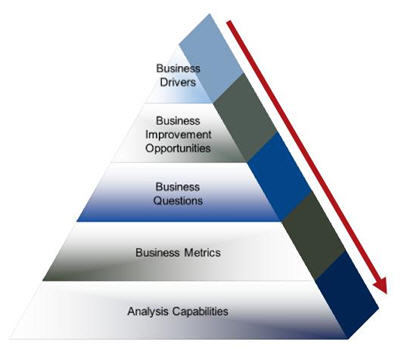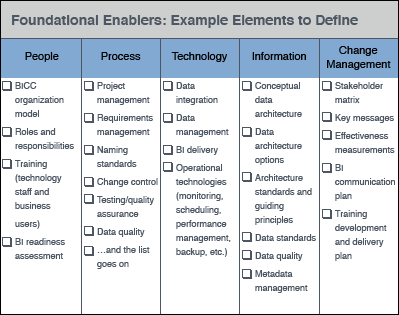





June 3, 2010
ANNOUNCEMENTS
New! TDWI Checklist Report: Operational Data Quality
CONTENTS

Does Your BI Strategy Have the Foundation for Success?

Mistake: “Cookie-Cutter” Consulting

See what's
current in TDWI Education, Research, Webinars, and Marketplace

Does Your BI Strategy Have the Foundation for Success?
Tony Lopykinski
Maven Advisors, LLC
Topics:
Business Intelligence, BI Road Map
I am often amazed by the response from prospective clients when I ask about their business intelligence (BI) strategy. Many organizations admit to not having a documented strategy. Others reference white board architecture diagrams, stacks of reports, or Microsoft Project plans.
Don’t get me wrong; many organizations are able to produce a documented approach for their BI programs. However, these strategies are often outdated or lack key elements.
What elements comprise a best-practice BI strategy?
- A business-aligned road map
- Five foundational enablers: people, process, technology, information, and change management
- A governance model for managing the strategy and executing the BI program
Your BI strategy should also answer three key questions: Where are we? Where do we want to be? How can we get there?
This article outlines a five-step approach to help ensure your strategy can answer these questions.
Step 1: Current State
A current-state assessment defines a baseline of your organization’s existing BI capability. Do not skip or short-circuit this step; it is difficult to get where you want to be if you are not sure where you started. The information collected during this assessment is essential for conducting the feasibility analysis and prioritization tasks of steps 3 and 4.
How do you define your organization’s current state? Start by collecting any documentation that exists for your business strategy, data and technical architecture, organization model, critical processes, and so on. Interview key technical and business stakeholders to get their perspectives and evaluate their competency to both deliver and utilize BI. Be honest with your evaluation; recognize current strengths and identify opportunities. Document your findings in detail, because this information will be crucial for future steps in the BI strategy development process.
Step 2: Future-State Vision
An effective BI vision depicts a top-down future-state view that is aligned with your organization’s overall business strategy. You are more likely to receive executive support--and funding--by supporting an existing strategy. In addition, strong business alignment makes it more difficult for BI resisters to argue with the impending change.
How do you define the future-state vision? Start by revisiting the business strategy and talking with your business stakeholders. Identify the business drivers that are critical to achieving corporate objectives. Next, determine the business improvement opportunities that can help your organization achieve those objectives. Third, identify the business questions, actions, and decisions BI must enable in order to impact the improvement opportunities. Finally, define the business metrics and analysis capabilities that your BI program needs to develop.
Step 3: Business Road Map
Begin the road map process by developing prioritization criteria that balance business value with cost and ability to deliver. With these criteria in hand, conduct a joint business and IT feasibility analysis to develop an iterative road map that is aligned to your current- and future-state capabilities and drives the greatest ROI.
How detailed should the map be? Don’t fall into the trap of trying to fully define metrics or report definitions at this time. BI capabilities on your road map should outline the sequence of business drivers, improvement opportunities, questions, metrics, and analytic capabilities being delivered. Each release will have its own project plan and detailed set of requirements. Foundational enabler initiatives, such as selecting a BI tool or upgrading servers, will likely have their own project plans as well.
Step 4: Enabler Road Maps and Action Plans
Ensure your organization has the necessary enablers in place to successfully execute its BI road map and achieve its strategic objectives. This is where the real work begins.
Prioritize foundational enabler projects and link them to your business road map to ensure successful delivery, maintenance, and support for your BI program. Keep in mind that these areas will evolve over time, so the map does not have to be perfect on day one. Develop action plans to iteratively evolve your organization toward best-practice capabilities. Periodically assess your progress in each of the five enabler areas and make adjustments to meet your changing business objectives.
Step 5: Governance and Execution
Now you must provide the necessary oversight to ensure your company’s BI program objectives are met and business benefits are realized. An effective BI governance process defines people, policies, and procedures. It must strike the right balance of process complexity, oversight, and control; it should be simple, so that people can easily understand and follow the process. A governance structure that is too constrictive or complicated will alienate business stakeholders from adopting and using your BI solution.
The initial governance program can be less formal in the early stages. Most of the stakeholders who helped you get to this point should continue within the various roles of governance. Let your company’s appetite and views on governance dictate how rapidly you can formalize the governance process.
Summary
In addition to the five steps outlined here, your BI strategy should capture the business benefits and ROI to your organization, as well as costs, funding plans, business risks, and potential issues.
Now that you have documented your comprehensive BI strategy, what’s next? Start by executing your BI communication plan developed in step 4. Share your BI vision to make the entire organization aware of your plans and to gain support. Finally, keep in mind that your strategy will need to be flexible, as business priorities will certainly change over time. The governance process defined in step 5 should include regular refreshes of the strategy to accommodate the imminent change.
Although having a well-defined BI strategy does not guarantee success, having a vision and a comprehensive plan for achieving it will dramatically increase your chances.
Tony Lopykinski is the managing principal of Maven Advisors, LLC, a management and technology consultancy specializing in business intelligence and data warehousing services to help organizations achieve their business objectives through the integration, management, and delivery of information.


Highlight of key findings from TDWI's wide variety of research
Adoption of BW
To gauge the adoption of NetWeaver BI Accelerator, TDWI’s survey asked of BW users: “Has your organization evaluated SAP BI Accelerator?” (See Figure 16.) A mere 5% of BW users have already deployed NetWeaver BI Accelerator, while another 5% are implementing it now, and 15% will be implementing it in the future. The adoption rate is low, but not bad, given that this is a new product. Adoption will probably pick up as more SAP customers evaluate it (25% are currently), and as the level of interest in data warehouse appliances in general continues to swell.
Source: Business Intelligence Solutions for SAP (TDWI Best Practices Report, Q4 2007). Click here to access the report.


FlashPoint Rx prescribes a "Mistake to Avoid" for business intelligence and data warehousing professionals.
Mistake:
“Cookie-Cutter” Consulting
By Dave Wells
Having a consultant with breadth and depth of experience is a good thing. Sometimes, however, the experienced consultant becomes the jaded consultant. When complacency sets in, the “seen it all, done it all” consultant is inclined to quickly classify needs, jump to conclusions about solutions, and redefine problems to fit preconceived recommendations. In extreme cases, some consultants modify reports and recommendations from previous consulting engagements and present them as analysis, findings, and guidance.
Some may ask, “So, what’s the problem? Didn’t the clients get analysis, findings, and guidance as agreed?” And this is precisely the problem. A consulting agreement implies more than that. Every client has a right to expect careful analysis, thoughtful findings, and sound guidance. The qualities of care, thoughtfulness, and soundness are exhibited only when the consultant recognizes that each combination of programs, projects, problems, and clients is unique.
Consultants can avoid falling into the cookie-cutter mode with one simple rule: Challenge your own experience. When you encounter a familiar situation, concentrate first on the differences, not on the similarities. Ask yourself what distinguishes this situation from those in the past. What is unusual or divergent from your experiences? Then, with this perspective, look at the similarities. Finally, confirm your understanding by summarizing for the client and seeking feedback.
Consumers of consulting services also have a responsibility to avoid cookie-cutter consulting. Again, one simple rule will help: Participate in analysis. Don’t become a passive recipient of consulting advice. Always participate actively in the analysis process.
Source: Ten Mistakes to Avoid For Successful BI Consulting (Q3 2007). Click here to access the publication.





